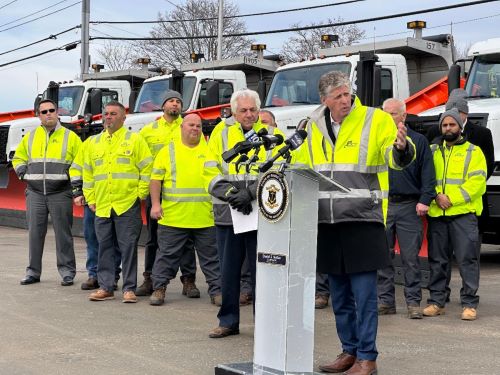Governor McKee and RIDOT Highlight Rhode Island’s Readiness for Winter Storms with 26 New Plow Trucks

EAST PROVIDENCE, RI – Governor Dan McKee and Rhode Island Department of Transportation (RIDOT) Director Peter Alviti, Jr. today discussed the state’s readiness for the 2023/2024 winter driving season, including an expansion and modernization of the state’s plow fleet with the addition of 26 new plow trucks this year.

The new trucks will help expand RIDOT’s state plow fleet to 168 trucks, increasing the state’s ability to handle storms in addition to its private vendor trucks. The Department will continue to clear the roads with the assistance of its reliable vendors, which add more than 260 trucks making a total of more than 425 trucks available for major storms.
“Rhode Island is well-positioned for whatever Mother Nature throws our way this winter,” said Governor McKee. “I’m proud of our team at RIDOT for modernizing and expanding its winter fleet as they continue to better maintain our roads and bridges and keep them safe for all users.”
“At RIDOT we are committed to providing safe, well-maintained roads for Rhode Islanders and the investment in these new vehicles is the latest sign of that commitment to make sure our Maintenance forces have the latest equipment to do their jobs and keep everyone safe this winter,” Director Alviti said.
The new trucks include seven six-wheel trucks and seven 10-wheel trucks – these are RIDOT’s largest trucks used to clear snow from the Interstates and other freeways. RIDOT this year also purchased 12 mid-size plow trucks that can be used for secondary roads or to work in tandem with lager trucks as needed.
Each of the larger trucks is equipped with GPS and other sensors that send information such as location, salt dispersal rates, and temperatures back to RIDOT’s storm operations center, allowing for better management of the fleet and RIDOT’s overall methods for clearing roads during storms.
The trucks meet the Environmental Protection Agency’s “Tier 4” emission standards, utilizing engines with advanced emission control technologies. Additionally, the trucks are fully undercoated and utilize stainless steel fittings in all hydraulic connections to extend the life of the trucks and protect them from corrosion.
In addition to the new trucks, RIDOT this winter is significantly expanding its network of weather stations from 11 to 36, with the addition of 25 state-of-the art sensors strategically placed throughout the state, including Interstate highways, large bridges, and other busy state roadways. These sensors provide information on air and surface temperatures and even provide information on the salinity level of water on the road. This information will help RIDOT manage salt usage especially in times of freezing rain or rapidly dropping temperatures when black ice formation is possible.
RIDOT also will continue to utilize hourly weather forecasting services and salt brine trucks to pre-treat the roads when possible to do so. The Department has 20 salt sheds and stockpiles which are fully loaded with 65,000 tons of salt on the ground and a system in place to readily replenish them as needed.
RIDOT budgets about $20 million a year for winter storm management. The Department responds to an average of 20-30 winter storms a year, often with rapidly changing conditions including heavy snowfall, rain, freezing rain, black ice, rapid freezing and even flooding. Maintenance forces are spread among seven districts statewide, able to direct the response as needed to meet the unique weather conditions in different parts of the state.
RIDOT offers these tips and suggestions for drivers to be ready for another season of winter driving:
- Get your car ready for winter conditions now. Make sure brakes, tires and batteries are in good shape and consider getting a tune up if it’s been a while. Snow tires are a good investment and can greatly improve safety when travel is unavoidable during a snow storm.
- Avoid unnecessary travel during storms, especially when snowfall is heaviest. Traffic congestion creates a snowball effect in which plows get stuck in traffic and can’t complete their routes in a timely fashion. In turn, roads become more snow covered between plow passes.
- Drive with care. If you absolutely have to be out during a storm, buckle up, reduce your speed, avoid distraction and never drive while impaired.
- Don’t crowd the plow – the safest place to be is a safe distance behind RIDOT’s plows and sanders. Do not attempt to pass plow trucks, especially on the right where large volumes of snow and slush are being pushed out of the lane of travel.
- Be patient. RIDOT and its vendor partners plow and treat roads on set routes, repeating them until the storm is over and the roads are clear. Be prepared for snow and slush-covered roads during storms while our crews do their job.